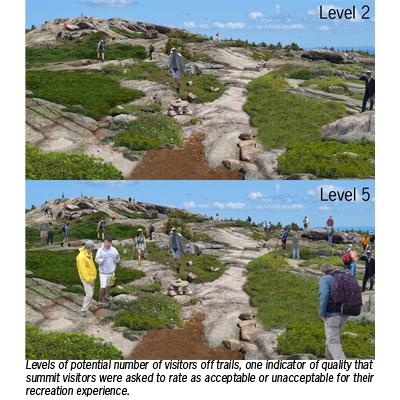Indicators and Standards of Quality for Recreation/Tourism: Research to Support Managment of the Northern Forest

Outdoor recreation/tourism, like other important uses of the Northern Forest, must ultimately be sustainable. Contemporary management and research approaches to sustainability in outdoor recreation/tourism (often called carrying capacity) call for formulation of indicators and standards of quality for natural resources and the visitor experience. Indicators of quality are ecological and social variables used to measure sustainability. Standards of quality define the minimum acceptable condition of indicator variables.
NSRC researchers conducted visitor surveys and environmental assessments on three mountain summits (Cadillac Mountain, Maine; Camel’s Hump, Vermont; and Cascade Mountain, New York) as these places are highly valued for the recreation opportunities they provide and the unique and fragile ecosystems they support. Researchers asked visitors to rate the following indicators of quality: acceptable number of visitors on and off trails, environmental impacts on and off trails, trail management practices, and management practices designed to keep visitors from walking off trail.
Visitors generally preferred low levels of resource impact, low visitor use levels, and little management presence. However, visitors preferred more intensive management practices to ensure that few visitors walked off-trail. Recreation-related impacts were observable at all three sites, though they were more severe on Cascade Mountain. Overall, visitors to all three sites reported experiencing resource, social, and managerial conditions that were better than what they considered to be minimally acceptable, suggesting that they are receiving high quality recreation experiences. Study data can be used to formulate indicators and standards of quality for other mountain summits to help ensure that outdoor recreation/tourism opportunities remain sustainable.
Download printable version [PDF]
Download full final report [PDF]
